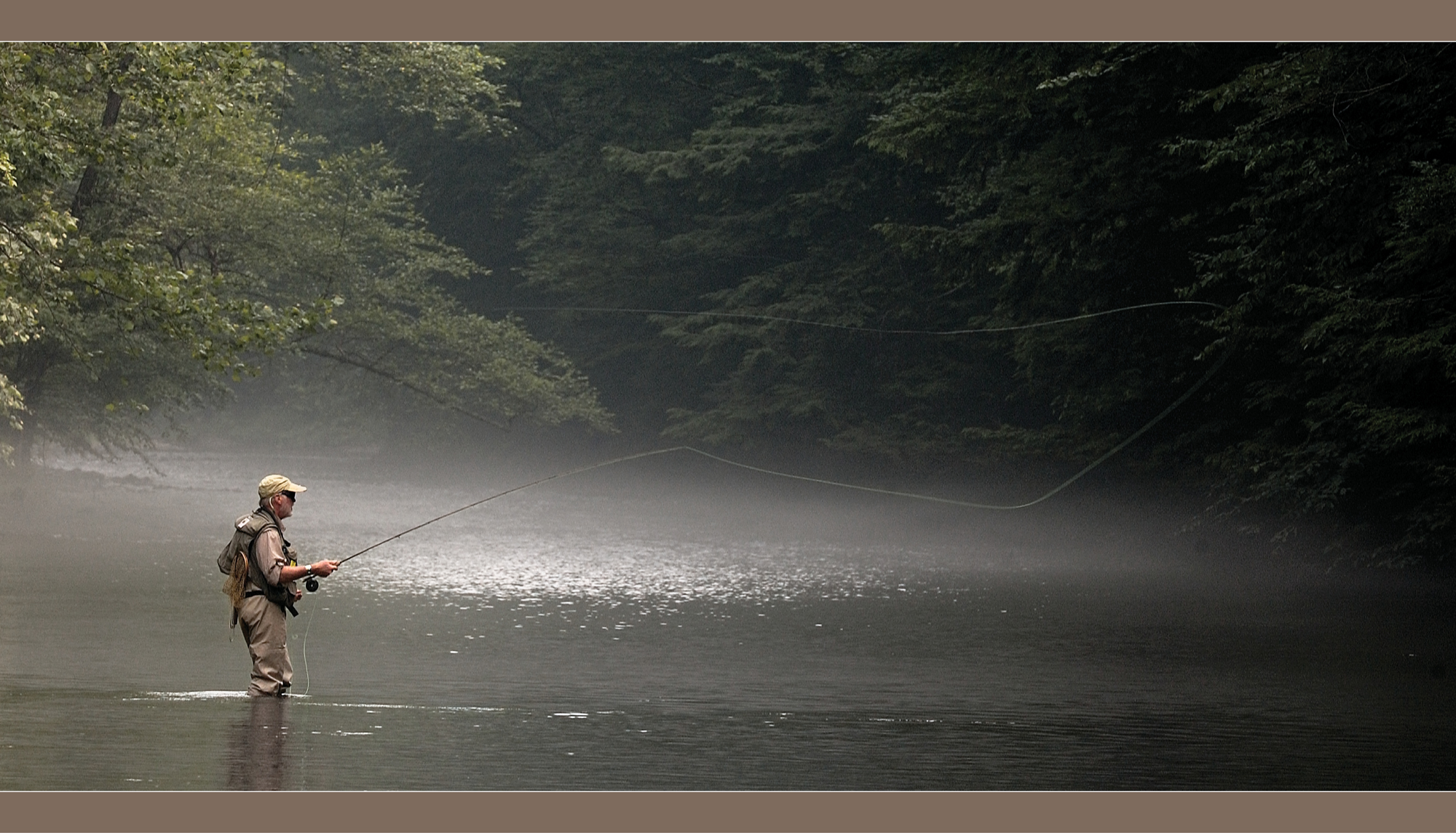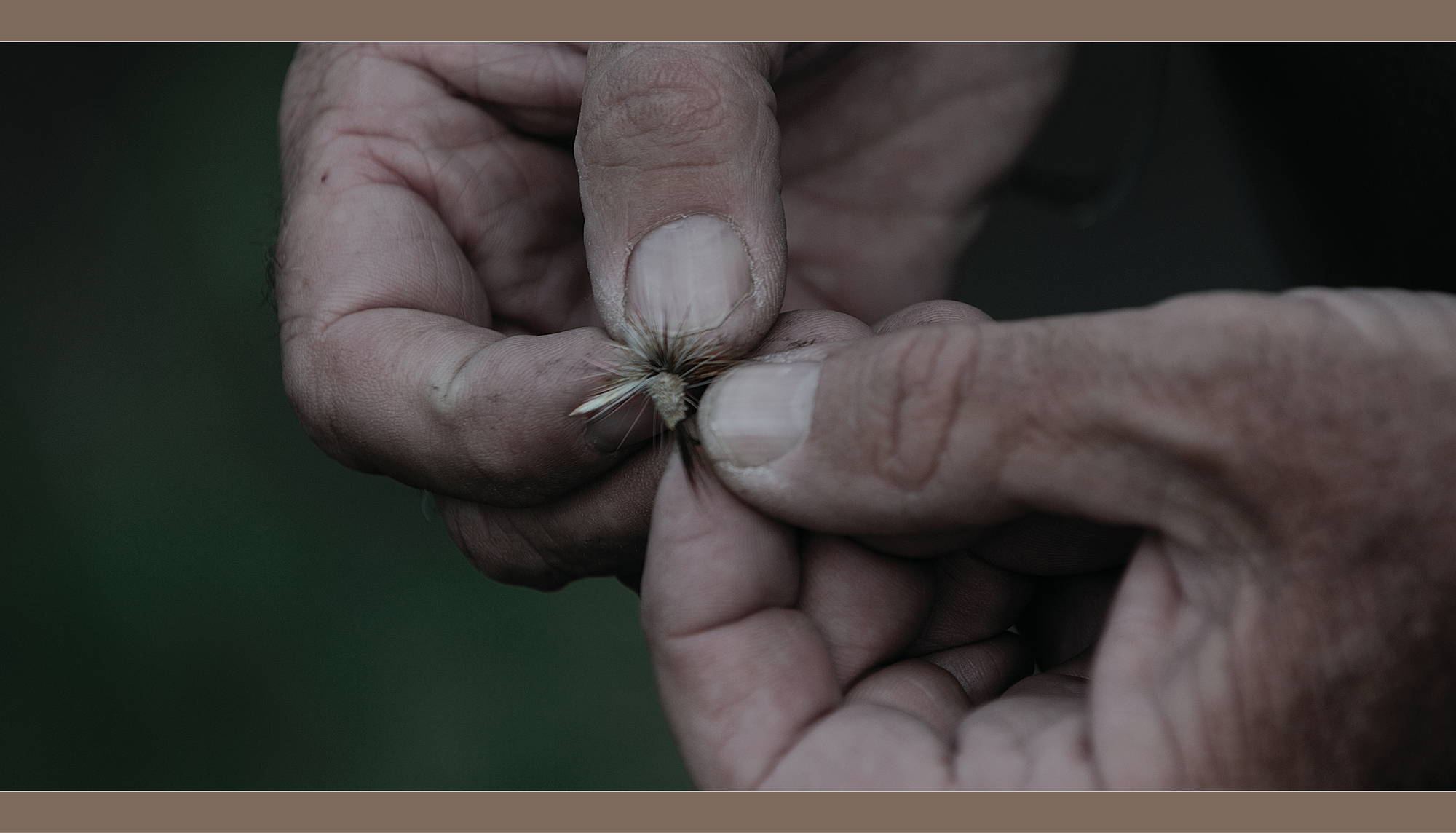
20 Aug Fiction: Happy is the Man by Peter Fong
THE OLD GUY REMOVED THE FLY from the fish — a pot-bellied brown of about 9 pounds — before turning his attention to Riley. “This,” he declared, “is not some trout stream in Montana.”
Riley nodded, wondering how the guy could tell that he lived on the other side of the Divide, where they measured the browns in inches. While nodding, he also took a shuffling, uncertain step forward, squinting at the unfamiliar pattern from what he hoped was a respectful distance.
“You want to catch minnows,” the old man growled, holding the fish upright in the current, “you go back out West.”
Riley tried to smile, or at least look friendly. He seemed to be getting better at both lately, incrementally better — that’s what Charlotte had said last night, wrapping a towel about her waist — but he was still unused to talking while fishing. To people, anyway.
Twenty years ago, he would have detoured around the guy, regaining the bank a few hundred yards upstream or down. Back home on the Madison or the Gallatin, he might have climbed into the truck and driven several miles to the next bridge or turnout. Not because he disliked other anglers, but from the singular desire to fish alone. That had seemed like the best way, the most uncomplicated, and hence the most satisfying.
But those days were gone. If Riley wanted solitude, he knew better than to hunt for it in Montana. And in any case, solitude, he had learned, was vastly overrated.
At 47, he had fallen in love with Charlotte, a professional fly tyer and professor of library science. Charlotte, whose sleek silvery hair reminded him of a seal, and whose forehead smelled of both sunlight and books. Charlotte who, at 49, had morphed into a professor of informatics, whatever that was. Something to do with communication theory, another undefinable topic, as foreign to Riley as codependency or personal transformation.
From what he understood, informatics was all the rage in France and Russia, but American practitioners had only two universities from which to choose: Indianapolis or Buffalo.
Gazing at the brown’s broad tail, wider than his own weathered palm, Riley reminded himself to be thankful for Buffalo.
“IT’S NOT WHAT YOU’RE USED TO,” Charlotte had said over the phone. “But I like it.” She had been gone a month at the time, and Riley felt like a backwater slough cut off from its spring. “You can borrow my 9-weight when you come.”
When I come? Riley had wondered to himself, unaware that he had been fishing for an invitation. He had wanted to tell her something, true. Not about how much he missed her company in the duck blind, at dawn — that was too easy — but something about her face in candlelight, the pendant curve of an earlobe, the press of her lips on a wine glass.
The words had welled up in his throat, until he thought he might speak. But instead he had listened, while Charlotte described a half-dozen Great Lakes tributaries, all within an hour’s drive of her rented Victorian.
They had selected three days in November and he had bought his ticket 30 days in advance, nonchangeable and nonrefundable. Scarcely a week passed before she received a last-minute invitation to a conference in Paris. Which she had accepted, of course.
He couldn’t blame her, then or now. They had spent two astonishing days together, mostly indoors, and he would be boarding a plane himself the following morning. But still.
He didn’t know what to say as she was leaving for the airport. What did you say to somebody who could lecture the French on “Data Availability and Social Exclusion”?
“Help me here,” Charlotte had said in the doorway, lifting his chin with the tips of two fingers.
Riley had looked over her shoulder into the predawn murk, watching as a few feathery flakes of snow drifted beneath the porch light. Then he had wrapped his arms around her, and kissed her, and murmured that he missed her in the duck blind.
HE HOOKED HIS FIRST-EVER STEEL HEAD only two hours later, standing thigh-deep at the base of an icy waterfall, daydreaming about Charlotte’s fingers, with an egg-sucking leech dangling 10 feet off the rod tip. The fight had been a brief, unmanageable comedy, the fish cartwheeling about the pool while he struggled to clear an errant loop from the reel handle.
When that fish was gone, Riley decided to take a walk downstream, to clear his head. There was a well-worn path winding through bare-limbed trees, intersected by slick chutes that led directly to the water’s edge, like beaver slides. Every obvious pool and lie hosted a rod or two or three, and Riley marveled at the cosmopolitan mix of tackle: the gleaming large-arbor spools, the stylish, two-handed wands.
He could still invoke an image of that steelhead suspended in air, impossibly bright and big, but fading like a flashbulb. Was it a good sign, he asked himself, that he could hook such a fish, on borrowed tackle, in unfamiliar territory? Or perhaps it meant nothing, since he had fumbled the fight. Or worse than nothing — because the big one had got away.
Charlotte’s 9-weight felt comfortable in his hand, the cork almost warm. He didn’t really mind losing the fish. Too bad about the fly, though. It had been the only shabby pattern in there, the only one that looked as if it had ever been wet. The rest resembled luminous globs of cheese, Charlotte’s roadkill experiments or stoneflies on steroids.
He wavered uncertainly before the tail-out of a narrow run, staring into the fly box while a stream of wader-wearing men broke around him, left and right.
SOME IN THE CROWD APPEARED to be newcomers like himself, but the old guy was evidently both an expert and a regular. Passing anglers greeted him by name as they slogged along the trail.
Although they called him “Hap,” Riley did not take the liberty. “Sir,” seemed more appropriate to his crusty demeanor, to the practiced nonchalance with which he could subdue a trout with one hand and light a cigarette with the other.
Hap wore hip boots and an arctic parka weathered to the color of a dried oak leaf. Since only one of his legs qualified as original equipment, he retired to the bank on a regular schedule — union breaks, he called them.
While Hap rested, Riley plied the water with renewed diligence. For some reason, it had become desperately important for him to land one of these oversized fish. He didn’t know exactly why, and resisted the urge to delve further. Maybe he just wanted something to talk about, something new to tell Charlotte, next week, when she returned from Paris. That was it. He didn’t have to explain himself to anyone — especially himself. Why did there have to be a reason for everything?
He glanced at Hap, hunched over yet another cigarette, eyes closed as if in pain. For the second time that morning, Riley wondered what the old coot had seen in him, what mark of the greenhorn? And then, because he was not, after all, an amateur — at trout fishing anyway — why did he not take offense? Why let Hap bluster on and on about synthetic yarns and nontoxic shot as if he knew no more about these topics than he did about love?
WHEN HE FINALLY ASKED HAP what fly he was using, a smile creased the codger’s face — at once triumphant and sly — as if he’d known Riley would concede sooner or later.
Hap had been experimenting all that week, and for several months before then, and for many, many years before that. On this particular day, this particular fly was undoubtedly the answer to any and all questions.
The pattern was his own invention. A deceptively simple combination of Darlon and Sparkleflash — not tinsel, his emphasis — tied on a no. 8 hook. Over the course of the afternoon, Hap gave Riley four of the little wonders: one with the barb broken off, for a model, then two fresh from his flybox, then another plucked from a 12-pound steelhead. “This one,” Hap assured him, “has already been educated.” Riley treasured each gift, even climbing a bankside tree to retrieve one that he’d snagged on a stout branch, after a botched hookset.
In addition to his flies, Hap offered a rejuvenated torrent of advice. His gruff voice carried so far above the river’s murmur that Riley had no choice but to do it precisely his way. This meant using the aforementioned fly, tied on a fluorocarbon leader (preferably Seaguar), with two splitshot, hefty enough to make an audible splat when they hit the water, 3 feet above the fly, no strike indicator.
“Cast directly across the current. Start close to your feet, then work gradually toward midstream. You have to feel the shot tickling the gravel. If you can’t feel it, you’re not fishing. Lift the fly and cast again. And again. Work in, then move out. Cover the water. Not so far upstream, you’ll snag that rock. If I were you, I’d replace that floating line with clear mono. Gives you better control. Cast farther, to that shadow. Don’t move your feet — it scares the fish. There! That’s a good brown. What did I tell you?”
Actually, it wasn’t as easy as it sounded. First, he had to watch Hap hook several fish to his one. That gave him plenty of time for close observation.
While Hap tussled with a headstrong rainbow, Riley dunked his new rig over a section of clear gravel. The two beefy shot quickly found bottom, hanging momentarily on a patch of mussels. In the heavy current, the fly streamed straight back like a tiny flag, waving precisely at a trout’s eye level.
Using an ordinary amount of weight on the leader, Riley would have had to cast a few yards above the slot he wanted to cover, to give the fly time to sink. With Hap’s method, the fly found its proper level in an instant. By casting across instead of quartering upstream, he also avoided the inevitable loops of slack, those ill-fated discontinuities that defied even his most precise mends.
Fishing downcurrent, on a tight line, the strike of a muscular brown or steelhead was unmistakable — a wonderfully addictive throb. Once Riley got the hang of it, he did not want to quit, pausing only briefly to thank Hap when the old man called it a day.
IT WASN’T UNTIL THE NEXT MORNING, on the plane back to Montana, that Riley recognized the magnitude of what Hap had done for him. His own instinct on the river, even under relatively sociable conditions, was for silence, if no longer outright solitude. Although he had worked as a teacher, he did not ordinarily seek opportunities to instruct others. And he would never have presumed, as Hap did, to insist that he knew best.
On one sunlit August day, nearly a decade ago, a novice angler had approached him on the Firehole, in Yellowstone Park. Riley had been having good luck fishing both wet and dry, on the same cast, with a single fly. Smaller rainbows mostly, quick to leap, with an occasional dogged cutthroat. He was using a small, sparsely dressed muddler — its deer-hair head trimmed into a tight, flattened cone. After a short upstream toss, he’d allow the muddler a temporary float as a hopper or stonefly imitation. As soon as the fly began to drag, however, he would jerk it beneath the surface — where the trimmed head functioned somewhat like the plastic lip of a diving plug — and finish the cast with a pulsing retrieve, swinging downstream and across the current.
He had learned the trick in 1976, from Charley Waterman, and it had remained a favorite method for prospecting grassy reaches on hatchless afternoons.
“How long you been fishing?” the rookie asked, his new waders fairly gleaming in the summer heat.
Riley shrugged. “Couple of hours.”
“No,” he said earnestly. “I mean, how long?”
The question confused Riley for a moment, as if he had been asked, How long you been breathing? But because he was younger then, he answered without unreasonable delay: “Twenty years, I guess.”
“I haven’t got that long.”
And when Riley merely stared in reply, standing mutely in the river, the tepid water breaking and rejoining behind his bare legs, the novice went on to describe his frustrations with casting. He’d taken a few lessons, of course, but his progress seemed so damn slow. He had an image in his head of what fly fishing should look like, but how the hell could he get there?
The best advice Riley could offer at the time was to pay less attention to casting and simply keep the fly on the water, where the trout could see it. Scant consolation then and — he realized now — wretchedly ungenerous.
What was Hap short for? Not hapless, certainly, nor haphazard. Happy, perhaps. Since they had never properly introduced themselves, Riley might not ever know for sure. But he did know what Hap would’ve done, in his place, on that day. He would’ve clipped the muddler from his leader and abruptly handed it over. He would’ve lingered on the bank, granting equal helpings of counsel and judgment. He would’ve recommended losing the waders, at least until September — when even the Firehole can get chilly — and enjoying what summer in Yellowstone had to offer.
He wondered, out of the blue, if Charlotte had met Hap. She would like him, Riley felt sure of that. She would appreciate his persnickety attention to materials, and enjoy his peculiar banter, the way he had of dispensing information like lengths of tippet. If she hadn’t met him yet, then Riley would give her a complete description. There couldn’t be that many individuals with the same passion for big trout, the same beneficence to strangers, the same gimpy leg. Given the distance between Bozeman and Buffalo, it would be January, at best, before he could wrangle another visit.
But he would talk with Charlotte before then. Really talk with her. No doubt she would know the guy, or know of him. “If you see Hap before I do,” he would ask her, “tell him thanks again, from me.”
Peter W. Fong is the author of the award-winning novel “Principles of Navigation,” and the head guide at Mongolia River Outfitters. He lives in Tangier, Morocco.
- Photo by Ken Takata
- Photo by Ken Takata
- Photo by Barry and Cathy Beck






No Comments